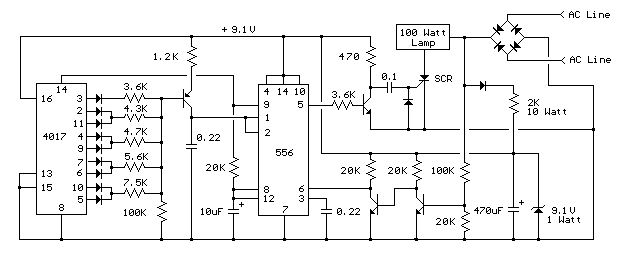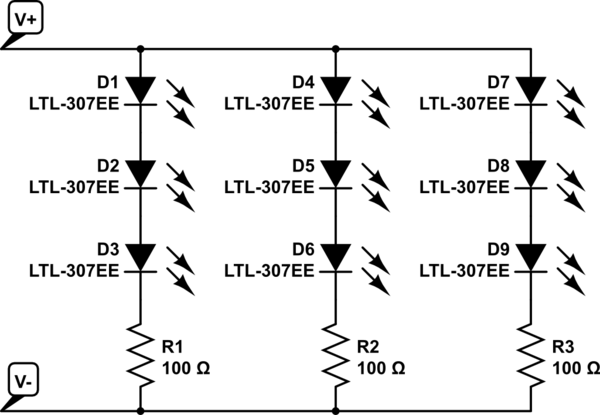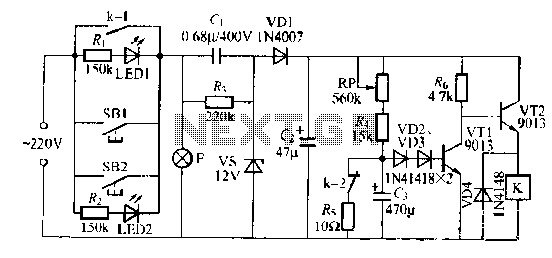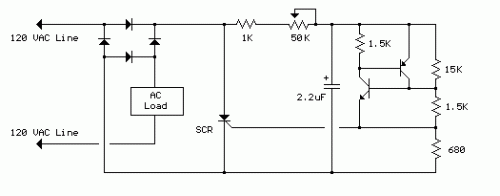
Sunrise Lamp

This circuit gradually illuminates a 120VAC lamp over an approximate 20-minute period. A bridge rectifier provides 120V DC to the MOSFET and the 60-watt lamp. A 6.2K, 5-watt resistor and a zener diode are employed to reduce the voltage to 12 volts DC for circuit power. The bridge rectifier must be rated for at least 200 volts and 5 amps. During operation, a 700 Hz triangle waveform is generated at pin 1 of the LM324, resulting in a slow rising voltage at pin 8.
The described circuit utilizes a bridge rectifier to convert the 120VAC input into a direct current (DC) output. The rectifier should be selected with a voltage rating of at least 200 volts and a current rating of 5 amps to ensure reliable operation under varying load conditions. The output from the rectifier is fed into a MOSFET, which acts as a switch to control the power delivered to the 60-watt lamp.
To provide stable operation for the control circuitry, a voltage reduction stage is implemented using a 6.2K, 5-watt resistor in conjunction with a zener diode. This combination steps down the voltage to a regulated 12 volts DC, which is necessary for powering the control components of the circuit. The zener diode ensures that the voltage remains constant, protecting sensitive components from voltage fluctuations.
The LM324 operational amplifier plays a crucial role in generating a control signal. Specifically, pin 1 of the LM324 outputs a 700 Hz triangle waveform, which is used to modulate the MOSFET's gate. This modulation allows for the gradual increase in power to the lamp. The slow rising voltage observed at pin 8 of the LM324 is indicative of the gradual illumination process, contributing to the desired 20-minute time frame for the lamp to reach full brightness.
This circuit design is particularly useful in applications where gradual lighting is preferred, such as in mood lighting or as a soft start for incandescent lamps, minimizing the inrush current and extending the lifespan of the bulb. The choice of components, including the ratings for the bridge rectifier and the resistor, is critical for ensuring the circuit's reliability and performance.In this circuit, a 120VAC lamp is slowly illuminated over a approximate 20 minute period. The bridge rectifier supplies 120 DC to the MOSFET and 60 watt lamp. A 6.2K, 5 watt resistor and zener diode is used to drop the voltage to 12 volts DC for the circuit power. The bridge rectifier should be rated at 200 volts and 5 amps or more. In operation, a 700 Hz triangle waveform is generated at pin 1 of the LM324 and a slow rising voltage is obtained at pin 8
🔗 External reference
The described circuit utilizes a bridge rectifier to convert the 120VAC input into a direct current (DC) output. The rectifier should be selected with a voltage rating of at least 200 volts and a current rating of 5 amps to ensure reliable operation under varying load conditions. The output from the rectifier is fed into a MOSFET, which acts as a switch to control the power delivered to the 60-watt lamp.
To provide stable operation for the control circuitry, a voltage reduction stage is implemented using a 6.2K, 5-watt resistor in conjunction with a zener diode. This combination steps down the voltage to a regulated 12 volts DC, which is necessary for powering the control components of the circuit. The zener diode ensures that the voltage remains constant, protecting sensitive components from voltage fluctuations.
The LM324 operational amplifier plays a crucial role in generating a control signal. Specifically, pin 1 of the LM324 outputs a 700 Hz triangle waveform, which is used to modulate the MOSFET's gate. This modulation allows for the gradual increase in power to the lamp. The slow rising voltage observed at pin 8 of the LM324 is indicative of the gradual illumination process, contributing to the desired 20-minute time frame for the lamp to reach full brightness.
This circuit design is particularly useful in applications where gradual lighting is preferred, such as in mood lighting or as a soft start for incandescent lamps, minimizing the inrush current and extending the lifespan of the bulb. The choice of components, including the ratings for the bridge rectifier and the resistor, is critical for ensuring the circuit's reliability and performance.In this circuit, a 120VAC lamp is slowly illuminated over a approximate 20 minute period. The bridge rectifier supplies 120 DC to the MOSFET and 60 watt lamp. A 6.2K, 5 watt resistor and zener diode is used to drop the voltage to 12 volts DC for the circuit power. The bridge rectifier should be rated at 200 volts and 5 amps or more. In operation, a 700 Hz triangle waveform is generated at pin 1 of the LM324 and a slow rising voltage is obtained at pin 8
🔗 External reference





